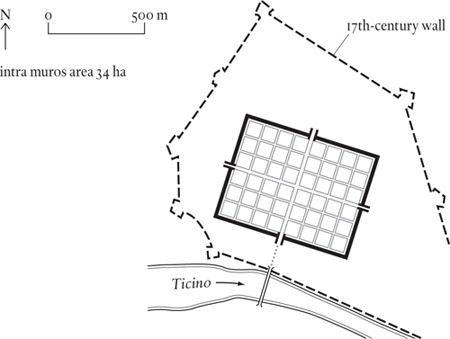
Lombardy, Italy
Classical Ticinum, a city in the eleventh region of Italy, subsequently the province of Liguria
Pavia seems to have been a lot more successful at maintaining its identity than in getting into the history books. Its origins are obscure, but it must have been founded as part of the Roman programme for nailing down the Transpadane lands in the second, or, at the latest, the early first century BC. However, the first firm date we have for it is provided by a dedication to Augustus (27 BC–AD 14), implying the existence of a monumental gate in honour of the emperor. The town plan will already have been established by then; to judge from the run of the existing streets it consisted of an array of 6 × 8 = 48 square blocks, covering thirty-four hectares.

In late antiquity, with north Italy under threat of barbarian invasion, Pavia started to attract more attention. The emperor Aurelian installed a mint in the town in AD 274, and a significant body of household troops must have been stationed there in 408 because it was their mutiny that led to the downfall of the Western generalissimo Stilicho. Theodoric the Ostrogoth used it as a winter headquarters and his successors as a stronghold for their treasure. Under the Lombards, who captured the town in 570, it became a capital city, although that is a distinction that has to be seen in the context of the time: the towns of Western Europe were approaching their nadir and, more specifically, MILAN had been knocked off its perch by the Ostrogothic sack of 539. The name ‘Pavia’ is Lombard; the classical name, Ticinum, is retained by its river, the Ticino.
The first reliable figure for Pavia’s population dates from the late fifteenth to sixteenth centuries when it had about 17,000 to 18,000 inhabitants. The intramural area by then was 160 hectares, giving a density figure of 106 to 112 per hectare. Applying this to the Roman area of 34 hectares produces a figure of no more than 3,800, so at its best in the fifth to eighth centuries AD, Pavia’s population is unlikely to have been much over the 5,000 mark.